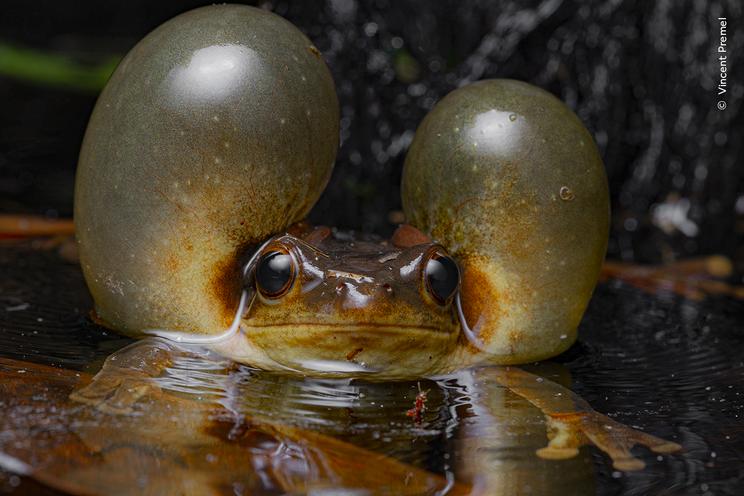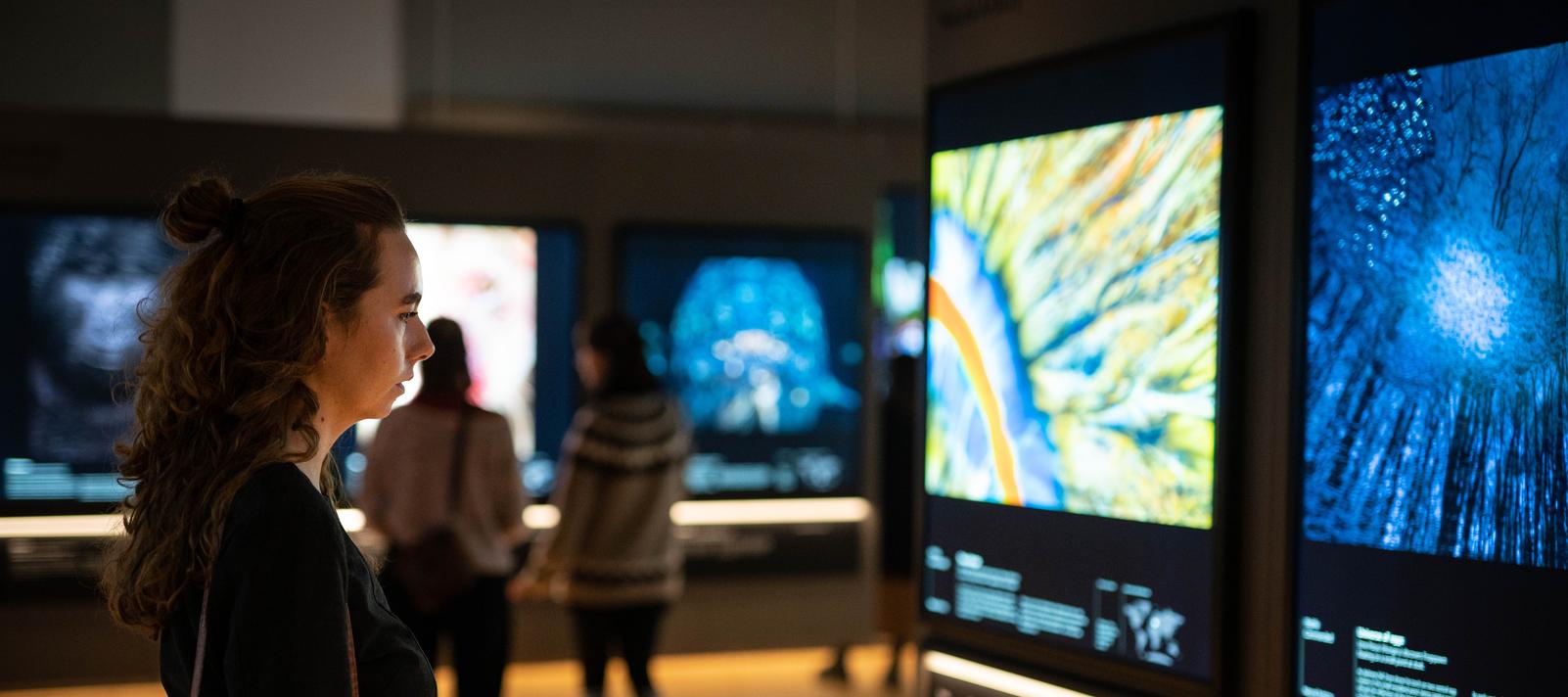People’s Choice Award
British photographer Ian Wood has won the 'People’s Choice Award' with his photograph 'No Access', capturing an ambling Eurasian badger glancing up at some rather familiar graffiti in St Leonards-on-Sea, England
The 25 nominated images for this year’s People’s Choice Award received a record number of votes with over 76,000 wildlife photography and nature fans from around the world voting for their favorite image.
Read the story behind Ian Wood’s winning image below and explore the other nominated photographs.
Press Contact
Bent Bøkman
Press Officer
Natural History Museum Denmark
University of Copenhagen
Phone: (+45) 53 83 30 41
Mail: bent.boekman@snm.ku.dk
Guidelines for Use of Photos
Photos on this page may only be used in connection with press coverage of the exhibition Wildlife Photographer of the Year (WPY60) at the Natural History Museum of Denmark.
The images are available for download in a web-friendly resolution for digital use only. Please click the information icon on each image to download.
For high-resolution images for print, please contact our press officer Bent Bøkman.
All requests for front cover use must be sent to wildpress@nhm.ac.uk.
A maximum of 25 images are available per media outlet.
Images should not be cropped or altered. Sensitive cropping is permitted with permission from the photographer.
PHOTO CREDIT IS REQUIRED. The credit information can be found in the image descriptions: [Photographer's name] / Wildlife Photographer of the Year.
Copyright must be clearly attributed to the photographer.
PLEASE READ terms and conditions for use of press photos.
'No Access' by Ian Wood (UK)
WINNER OF 'PEOPLE'S CHOICE AWARD 2024'
British photographer Ian Wood’s perfectly timed capture of an ambling Eurasian badger glancing up at some rather familiar graffiti in St Leonards-on-Sea, England, has won this years 'People’s Choice Award'.
After residents of St Leonards-on-Sea, England, had been leaving food scraps on the pavement for foxes, Ian noticed that badgers from a nearby sett were also coming to forage. Having seen a badger walking along the pavement by this wall late one night, he decided to photograph it and set up a small hide on the edge of the road to take his picture. Only the light from a lamppost illuminated the creature as it ambled along.
Ian Wood says: “The outpouring of badger love since my photo was nominated for the 'People’s Choice Award' has been beautifully overwhelming. Finding out that it has won is truly humbling. However, there is a darker side to this image. I live in rural Dorset where I’m on a re-wilding mission to enhance habitats for a huge array of wildlife. The badger cull – which is still ongoing – has decimated their numbers and I fear that unless the cull is stopped, we’ll only see badgers in urban settings in several parts of England. My hope is for this image to raise awareness of the damaging effect of the badger cull and help push for change.”
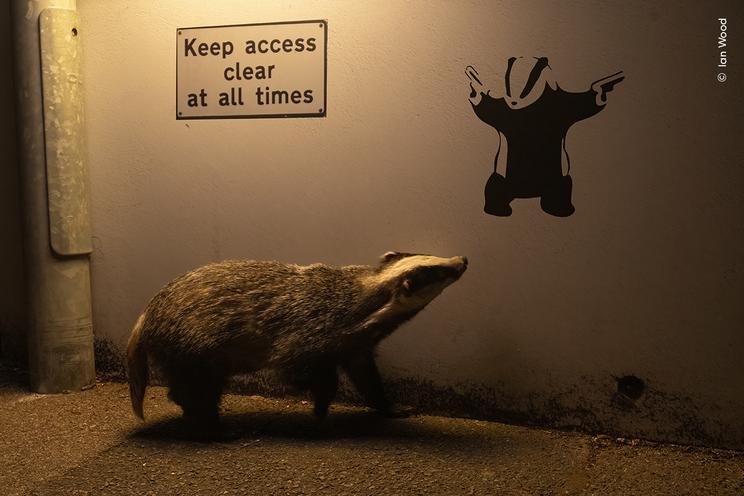
'Curious Connection' by Nora Milligan (USA)
A chimpanzee pauses and looks down as its family moves across the forest floor of Loango National Park, Gabon.
On a trek through the forest, Nora’s guide signalled for the group to stop near the bank of a swamp.
They heard the call of a chimp first, then the leaves around them started to rustle and a group of chimpanzees appeared. This family is called the Rekambo group. A group of researchers from the Ozouga Chimpanzee Project is studying them.
Nora couldn’t believe her luck when they started to climb the nearby trees. As she peered through her viewfinder, a large male paused and looked down at them.
The chimp craned its neck forward and its eyes seemed to widen, as if to get a better look.
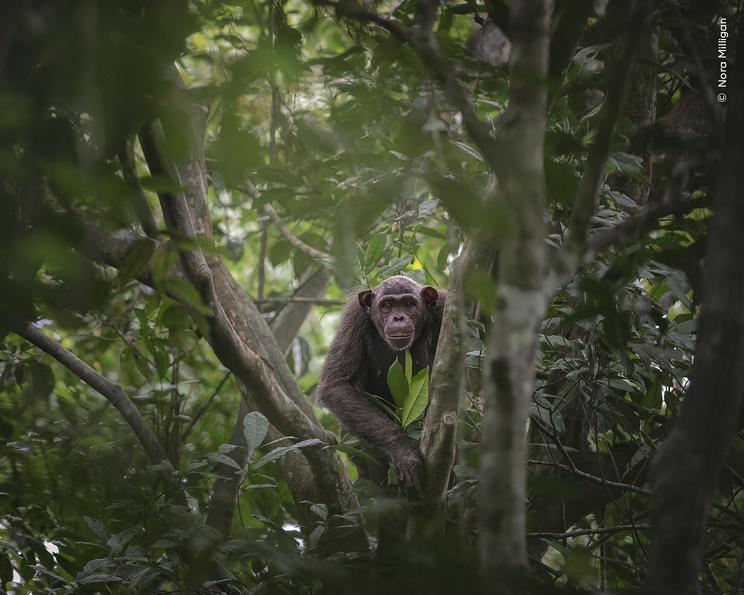
'Edge of Night' by Jess Findlay (Canada)
A ghostly barn owl exits the hayloft window of a derelict barn to hunt in fields outside Vancouver, Canada.
Jess quietly watched the owl for several nights to understand its habits.
He set up an invisible beam so that his camera flash would trigger when the owl flew out of the barn. His camera took a series of long-exposure shots, capturing ambient light cast on the clouds and barn.
It was a complicated setup but, to Jess’s amazement, it worked the first time.
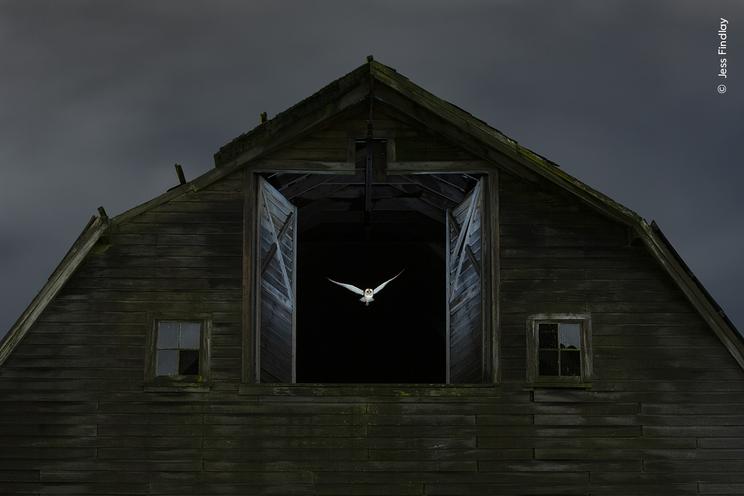
'Icy Repose' by Sue Flood (UK)
A dramatic blue-grey sky highlights the soft greys of a Weddell seal as it rests on an ice floe.
Sue watched this Weddell seal from aboard a rigid inflatable boat in Neko Harbour of the Antarctic Peninsula.
So as not to disturb its peaceful slumber, Sue used a long lens to record this serene portrait.
Weddell seals’ large bodies are covered in a thick layer of blubber. This keeps them warm above and below the icy waters of the Southern Ocean.
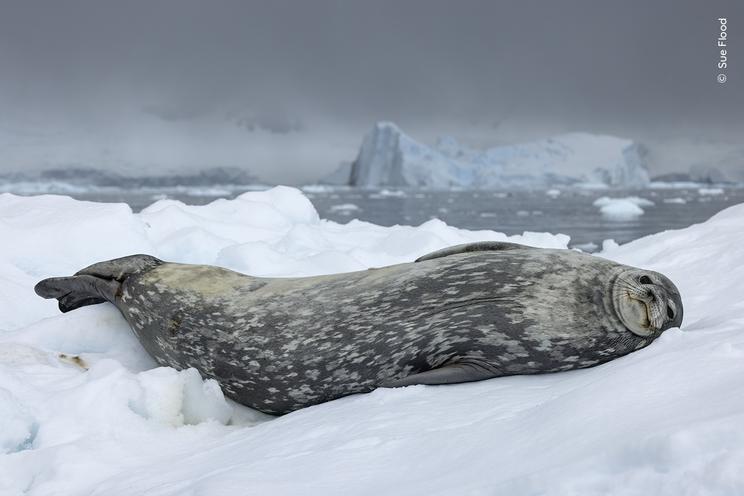
'Snuffling Sengi' by Piotr Naskrecki (Poland)
A rarely seen four-toed sengi forages for food among the leaf litter in Mozambique.
Sengis mainly eat insects and look for their prey at dusk and dawn. They rely on a combination of good vision and excellent sense of smell to find food.
Piotr watched this sengi over several weeks in Gorongosa National Park, Mozambique. It followed the same network of trails every day, looking for beetles and other tasty morsels among the leaf litter.
Sengis are extremely shy and skittish, so Piotr set up a remote camera to photograph the little creature sniffing for food.
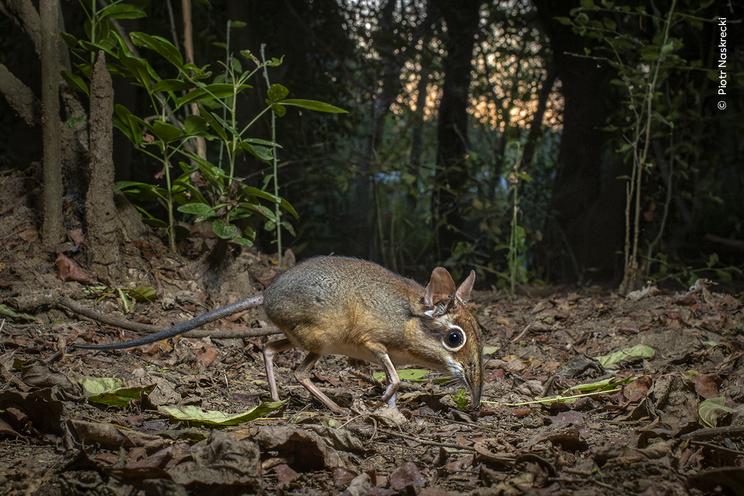
'Whiteout' by Michel d’Oultremont (Belgium)
A stoat sits up and observes its territory as it blends perfectly into a snowy landscape in Belgium.
Michel had been looking for stoats in the snow for many years.
The magic of snowfall fascinates Michel every winter. He wanted to take a photograph that showed how the stoats blend in with the whiteness of the landscape.
He’d seen a few in Switzerland but never in his native Belgium. Then, finally his dream came true.
He lay in the snow with a white camouflage net covering all but his lens.
This curious stoat came out of its snowy hole and sat up from time to time, observing its territory just before setting off to hunt.
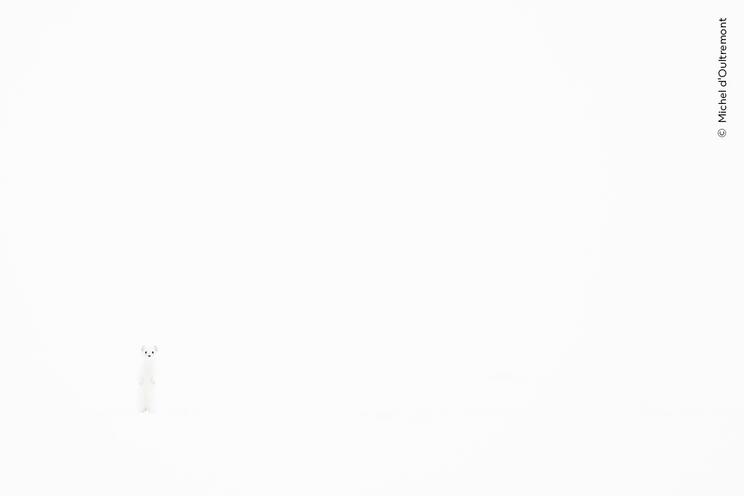
'Earth and Sky' by Francisco Negroni (Chile)
A double lenticular cloud is illuminated at nightfall by the lava emitted from the Villarrica volcano, Chile.
Villarica is in the town of Pucón in the south of Chile. It’s one of the country’s most active volcanoes and last erupted in 2015.
Francisco takes regular trips to Villarrica to monitor its activity. On this visit, he stayed nearby for 10 nights.
He says every trip is “quite an adventure – never knowing what the volcano might surprise you with”. Some nights are calm, others furious as in this photograph, where the brightness of the crater illuminates the night sky.

'Wolf Pack' by Arvind Ramamurthy (India)
Members of an Indian wolf pack pause briefly as they play in fields in Bhigwan, India.
Indian wolves were once found all across India. Now, their number has dwindled to as few as 3,000.
Living so close to humans poses many risks. Farming has fragmented their rolling grassland habitat, and feeding on cattle carcasses puts them at risk of disease.
But Indian wolves are hardy animals. With better grassland management and protection, they could make a strong comeback.
Arvind was photographing this pack playing in the grassy fields. One of them came and sat down at the edge of the agricultural crop, and one by one four others joined it. They paused for a few seconds before they ran off again, playing and chasing one another.
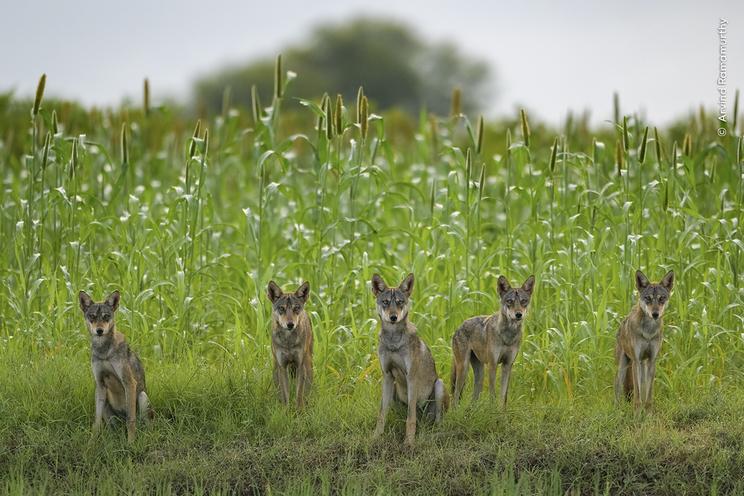
Scanning the Realm' by Aaron Baggenstos (USA)
A puma stands on a windswept outcrop in the rugged mountain terrain of Torres del Paine National Park, Chile.
It is a symbol of hope. A successful conservation movement led to the creation of the national park and a rise in ecotourism in the region.
This has also helped to reduce conflict between pumas and local gauchos (sheep farmers). The gauchos view pumas more positively because they’re attracting tourists, which is good for income.
The introduction of sheepdogs has also helped. The dogs confront any approaching pumas and stop them attacking the sheep. In turn, the pumas hunt their natural prey, and the gauchos are less likely to shoot them.
The change has been gradual but has gained momentum over the past 20 to 30 years. There is hope that humans and pumas can live alongside one another.
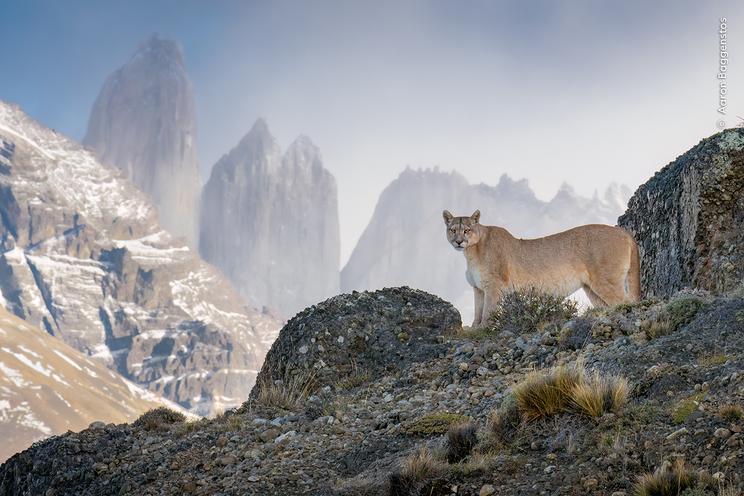
'Togetherness' by Ivan Ivanek (Czech Republic)
A striking pair of red-shanked douc langurs are seen mating in the forests of the Sơn Trà peninsula in Vietnam.
Known for their bright red ‘stockings’, these primates are found only in Vietnam, Laos and Cambodia.
The species is critically endangered because of habitat loss, hunting and the illegal pet trade.
After days observing the area looking for evidence of the monkeys, Ivan managed to find a small group.
Late one evening, he saw these two mating. Compared to other species of monkey he’d seen mating, it was an unexpectedly gradual and graceful affair!
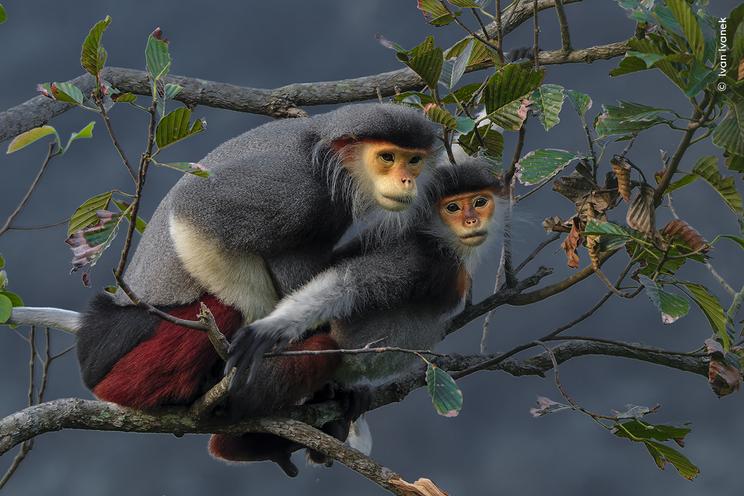
'The Arrival' by Brad Leue (Australia)
Floodwaters that have travelled for months surge towards an enormous salt lake in South Australia.
Kati Thanda-Lake Eyre is Australia’s largest inland lake and one of the world’s largest salt lakes.
Photographing from a helicopter in strong winds was quite a challenge for Brad. As well as the floodwaters, a dust storm was blowing and rain was falling on the horizon.
Floodwaters had travelled more than 1,000 kilometres (1,600 miles). They’d surged steadily from Queensland towards South Australia.
Timing was imperative to photograph this once-in-a-decade natural event.
Brad’s image shows the water channelling steadily down Warburton Groove. This is the final stretch before entering the mighty lake.
On their journey, the waters bring new life to this remarkable desert system and its rare and threatened wildlife.
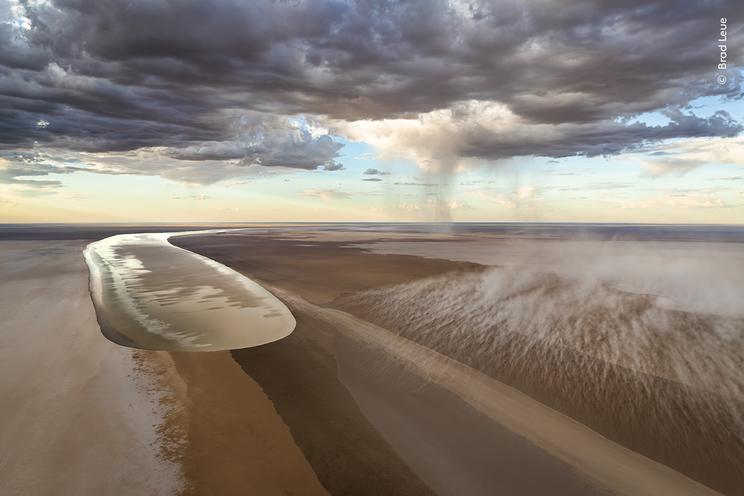
'Annoying Neighbour' by Bence Máté (Hungary)
A European roller defends its territory from a bemused-looking little owl in Kiskunság National Park, Hungary.
The little owl and the European roller are very different birds, but their nests and feeding requirements are similar. This means they sometimes breed near each other.
The male roller makes a sport of annoying other birds that stray into its breeding area during the short mating season. It makes a surprise ambush, flying at full speed behind them.
To catch such a fleeting scene, Bence spent 27 days watching from a hide. The little owl seemed nonplussed by the spectacle.
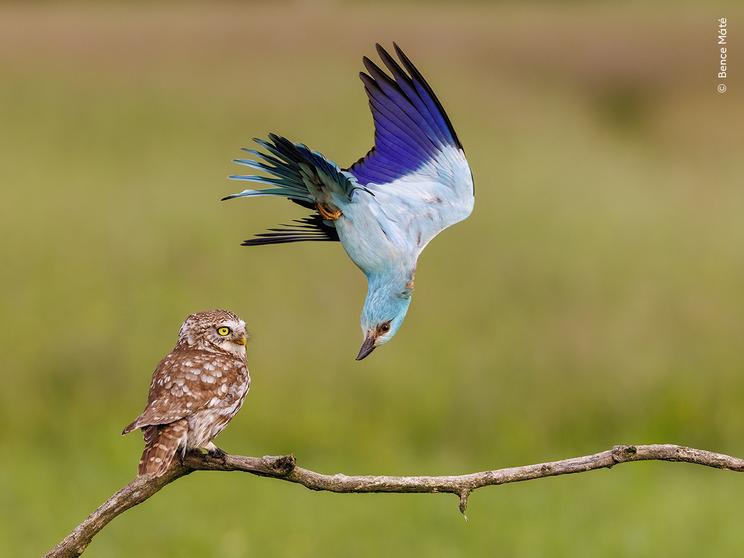
'Fallen from the Sky' by Carlo D’Aurizio (Italy)
A collage of dead butterflies and moths trapped by the surface tension of the water floats in a stream in Italy.
It was a summer morning in the San Bartolomeo valley, in the Majella National Park, Italy.
Carlo had visited this small stream many times. He expected to see the graceful flight of butterflies and dragonflies along it.
He never thought he would find such a still life, a sad collage of dead insects calmly floating in the water.
It hadn’t been particularly hot and there hadn’t been any storms in the previous days. To this day Carlo has no explanation of why the insects died.
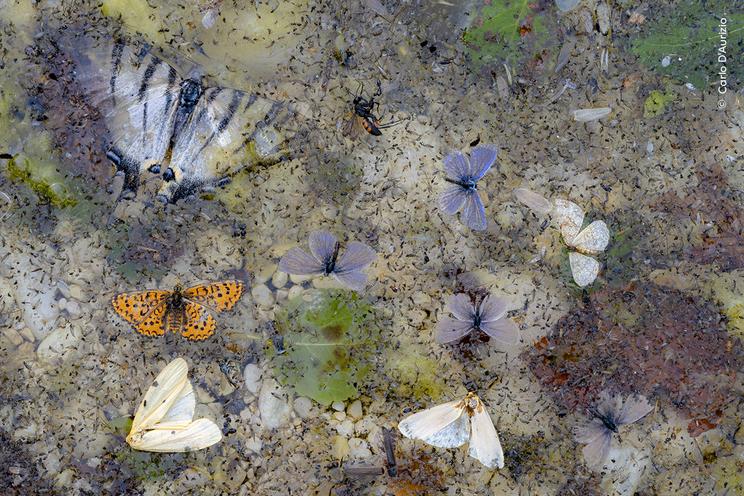
'Evening Song' by Christian Brinkmann (Germany)
A singing Eurasian songbird is silhouetted against a backdrop of colourful fairground lights in Münster, Germany.
During a popular fair in Münster called the Send, an interesting atmosphere arose behind the castle.
The evening mood was gentle, and Christian had singing birds on one side and party music on the other.
In front of the fairground lights, this Eurasian blackbird posed for its song.
Although blackbirds are a common sight, Christian likes to photograph them in distinctive ways. Here, the silhouette of the bird set against a colourful backdrop gives the image an artistic flair.
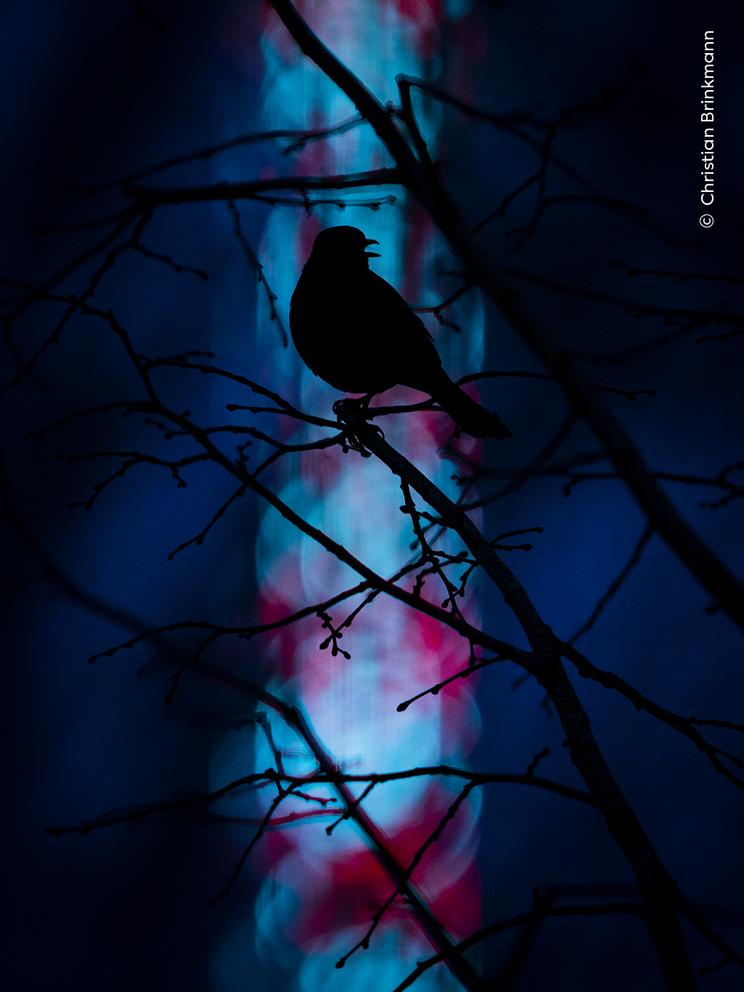
'Aspen Shadows' by Devon Pradhuman (USA)
Four grey wolves cross a minimalist landscape of naked aspens and snow in Yellowstone National Park, USA.
It was early spring in the Lamar Valley, and this pack was in search of its next meal.
Watching from a distance, Devon saw them heading towards this patch of aspens and thought it would make a compelling image.
The wolves walked right past these trees and then continued to follow the tree line, eventually disappearing over the hillside.

'A Good Scratch' by Mark Williams (UK/Canada)
A beluga whale rubs its underside on a shallow river bottom to exfoliate its skin.
Mark took this image in a remote inlet along the Northwest Passage in the Canadian Arctic.
Hundreds of beluga whales come here to socialise and exfoliate in the shallow water. The passage is also a safe haven, away from the predatory orcas.
Belugas are extremely sociable mammals. They live, hunt and migrate together in pods that can range from quite small into the hundreds.
Nicknamed ‘the canaries of the sea’, they produce a series of chirps, clicks, whistles and squeals that Mark found otherworldly.
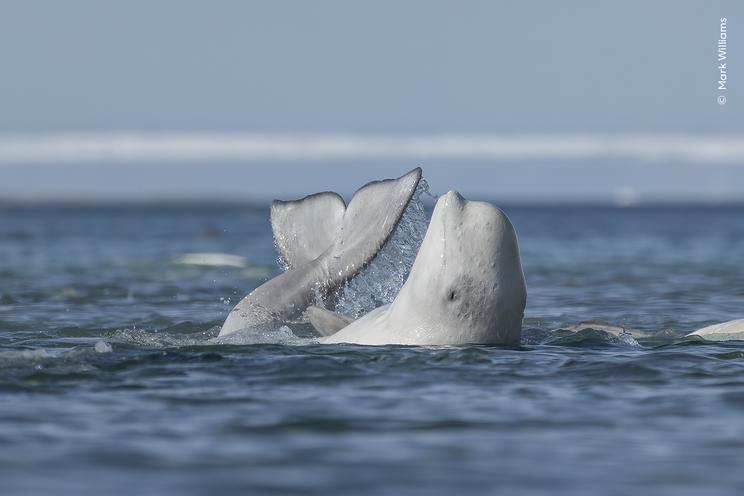
'Unsold' by Jose Fragozo (Portugal)
A young cheetah cub hisses while waiting to be sold in Ethiopia.
Captured from her home plains in the Somali Region, she was transported for several days on the back of a camel to the northern coast of Somaliland.
Illegal wildlife trafficking is a problem in the Somali Region. Farmers catch and sell cheetah cubs to traffickers, claiming that the cheetahs attack their livestock.
Sometimes the farmers and traffickers cannot sell the cubs immediately. The bigger the cheetahs get, the harder it is to find buyers.
Some end up being killed and their parts sold, their bones shipped to Yemen and then to other Asian markets. They are then sold as tiger bones and used to make Chinese bone wine.
After hissing at the camera, the cub started chirping, calling out for its mother.
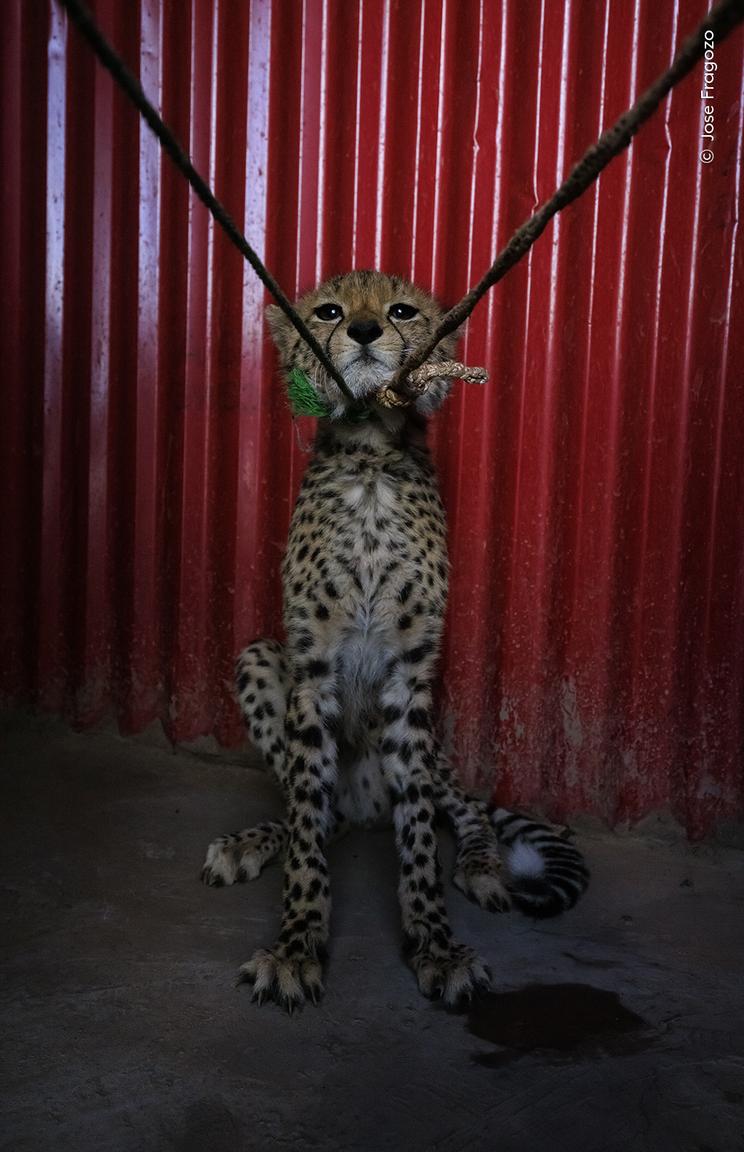
'Meeting in the Marsh' by Michael Forsberg (USA)
A disguised biologist approaches an endangered whooping crane in Louisiana, USA.
Michael has been chronicling the lives of endangered whooping cranes since early 2019.
The biologist acted with cat-like quickness to check the bird’s health and change a transmitter that was no longer working.
The transmitter helps biologists track these non-migratory birds and learn more about them.
This experimental population was reintroduced in Bayou Country in 2011. In the 1940s there were roughly 20 whooping cranes in the region. Since then, numbers have climbed to over 800.
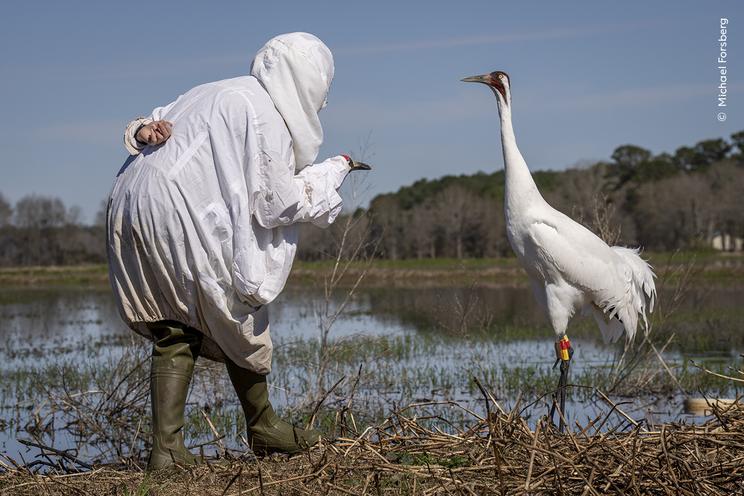
'Sneak Attack' by Erlend Haarberg (Norway)
A polar bear cub attempts an underwater surprise attack on a northern fulmar.
In the Norwegian archipelago of Svalbard, a walrus carcass had attracted a female polar bear and her two cubs.
But one of the cubs was more interested in playing in the water than eating.
The cub was having fun diving under the water and resurfacing, playing with the seaweed and kelp.
The northern fulmar resting on the surface of the water awakened the cub’s desire to hunt.
Erlend watched as it attempted several underwater surprise attacks on the bird, only to fail each time.
Play hunting like this is essential learning for a young bear. Eventually it will have to survive in the Arctic without its mother.
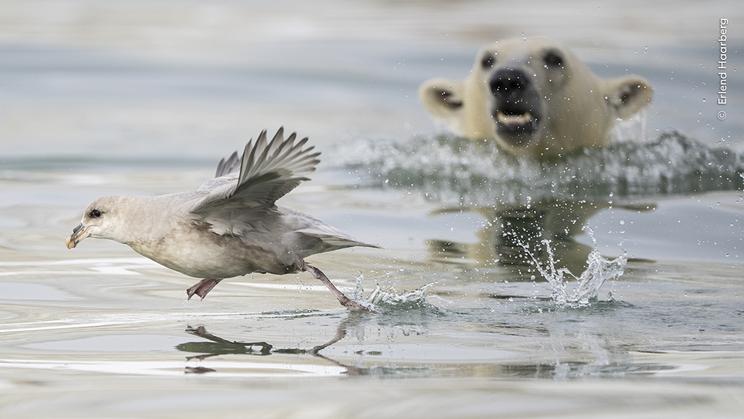
'Slap Shot' by Savannah Rose (USA)
A beaver cocks its tail before slapping it down on the water to alert its family to a newcomer.
Savannah enjoys photographing North American beavers in this pond in Jackson, Wyoming, USA.
As she approached the shoreline, a beaver cruised cautiously by after emerging from its lodge. It cocked its tail up and brought it down with a resounding crack.
Savannah had been trying to document this dramatic beaver behaviour for years.
Beavers use tail smacks to alert their family group to a newcomer. Despite the theatrics, beavers usually relax quickly after discovering the newcomer doesn’t pose a threat.
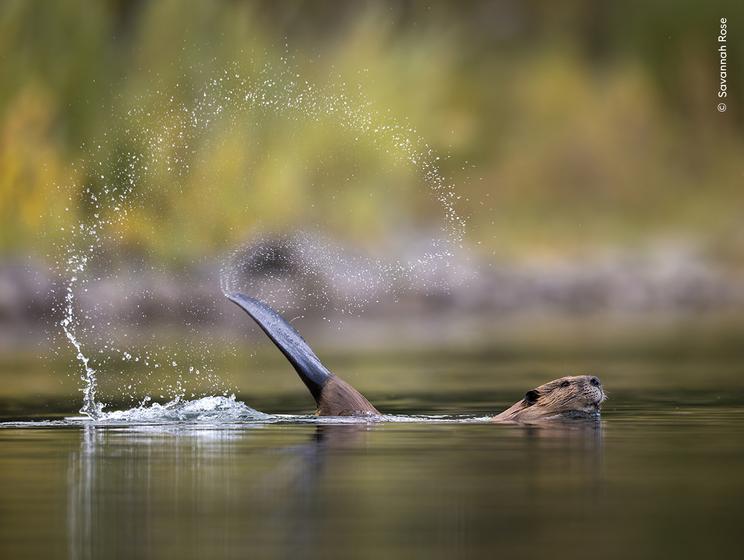
'The Brave Gecko' by Willie Burger van Schalkwyk (South Africa)
A giant ground gecko stands fast against a pale chanting goshawk in Kgalagadi Transfrontier Park, South Africa.
One hunting strategy of the southern pale chanting goshawk is to walk or run on the ground in pursuit of prey.
Willie watched as the little lizard put up a brave fight against its large attacker.
Unfortunately, there was no hope of survival, but Willie was impressed by the gecko’s bravery.
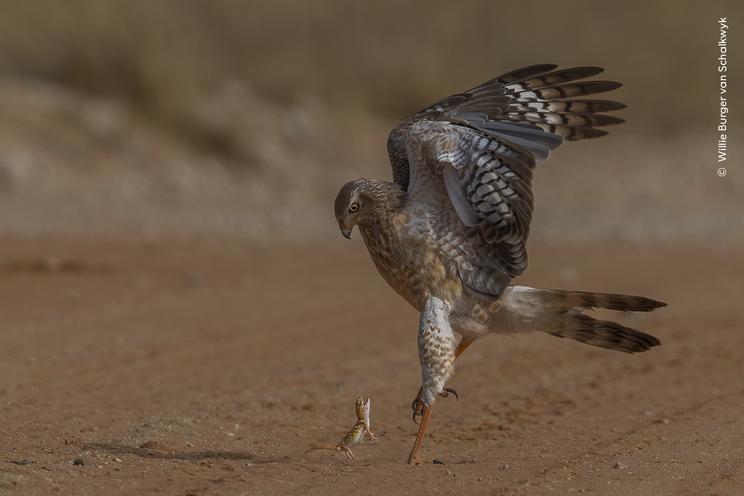
'Forest of Dreams' by Samuel Bloch (France)
A northern giant petrel sits on its nest at the edge of a rātā tree forest on Enderby Island, New Zealand.
Northern giant petrels are large seabirds. They’re used to flying above the waves for weeks without encountering land.
Samuel was surprised to find this one in such a woody environment.
Like many other seabirds, it breeds on islands where there are fewer predators.
Samuel took this image from a distance and left quickly to avoid disturbing the bird.
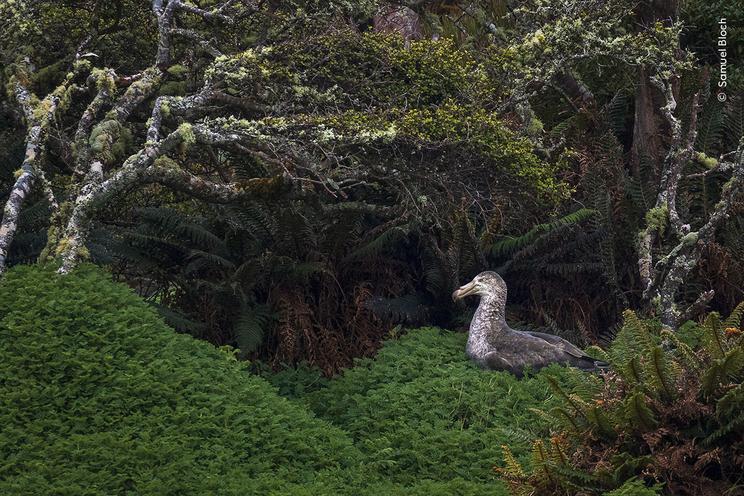
'Spiked' by David Northall (UK)
A bloodied yet determined honey badger returns to finish off a Cape porcupine, which earlier had tried to defend itself.
Found throughout Botswana, honey badgers are famously ferocious. They often chase animals many times their own size.
This honey badger got an unpleasant surprise when it attacked the normally nocturnal Cape porcupine.
The badger grabbed the porcupine’s right leg. In defence, the porcupine repeatedly backed into its attacker, piercing it with many quills.
During a lull in the attack, the porcupine managed to shuffle away, its leg badly damaged.
After a short retreat, the bloodied badger returned. It finished off the porcupine under a bush close to the original attack then dragged it into its underground den.
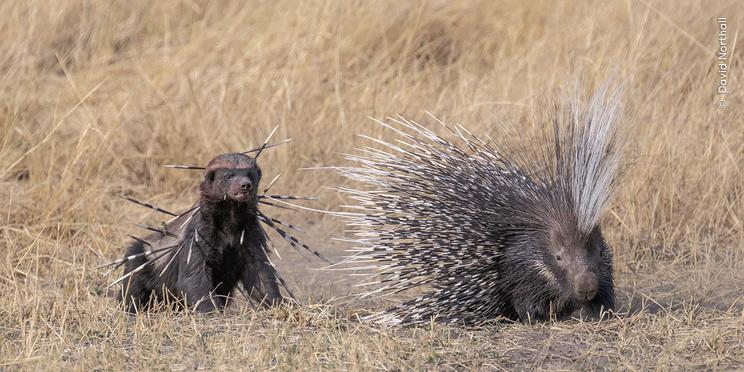
'Drifting Dinner' by Noam Kortler (Israel)
A decorator crab perches on top of a sea squirt to comb the water for drifting plankton.
Noam took this photograph during a night dive off Komodo island, Indonesia.
The sea squirt provided the crab with the perfect stage to feed on drifting plankton.
The crab had camouflaged and armed itself with tiny hydroids known as Tubularia. These can sting other animals and so helped protect the crab from predators.
Noam watched the crab gracefully search for food, illuminated by the camera flash as if in a spotlight centre stage.
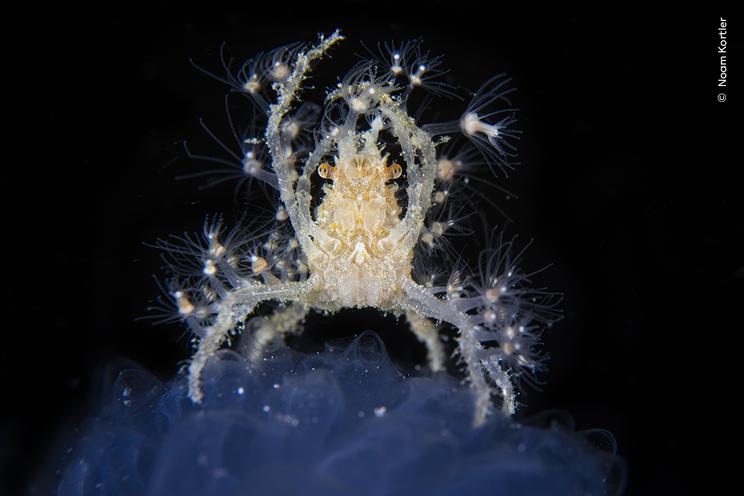
'Concert in the Forest' by Vincent Premel (France)
A Surinam golden-eyed tree frog puffs out its cheeks as it prepares to call for a mate.
The first rains come in French Guiana after a long dry spell. They’re a release for all wildlife, but especially for amphibians.
When it rains, the ponds fill with water. Dozens of species descend from the canopy or come out of the ground. They’re here to lay their eggs in the water, in an event called ‘explosive breeding’. The density of individuals is hard to imagine.
It made for a special night for Vincent, who is both a herpetologist and a photographer.
The call of the Surinam golden-eyed tree frog is so powerful it can be heard hundreds of metres away.
